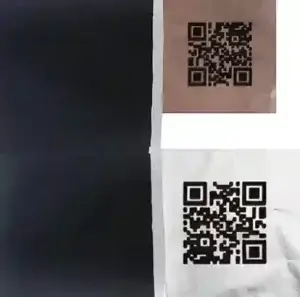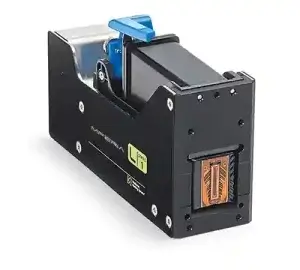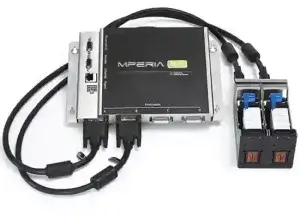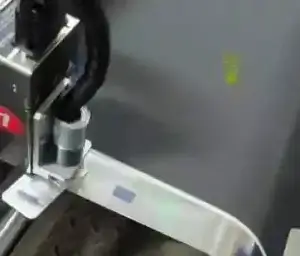How Inkjet Printers Boost Lithium Battery Manufacturing Efficiency, Product Quality
Global demand for Li-ion batteries is expected to soar over the next decade. According to McKinsey, demand will grow by about 27% annually through 2030. As demand – and competition — grows, the pressure on manufacturers to produce quality products at low cost will only intensify.
Lithium coatings play a crucial role in battery performance and safety. In lithium battery manufacturing, it is essential to detect defects in these coatings early on to ensure the battery’s performance and safe operation. Detecting defects early also helps to improve efficiency, lowering manufacturing costs overall.
Let’s look at how an automated detection system integrated with inkjet printers, developed in partnership with Matthews and leading battery manufacturers, can help address a key problem – how to accurately detect, locate and eliminate defects in real time.
The costly problem with coating defects
One of the common defects in lithium battery manufacturing is uneven lithium coatings on both the anode and cathode foils.
A lithium coating slurry is applied to a roll of metal (copper or aluminum), but it doesn’t always apply evenly. This can cause serious issues with battery performance. For example, uneven coating of the cathode or anode will ultimately result in poor battery construction and create a hotspot, which could lower the battery’s efficiency and shorten its lifespan.
The challenge for lithium battery manufacturers is to detect these coating defects during the manufacturing process to ensure they don’t cause issues downstream.
Inline detection and marking of defects early on ensure manufacturers can identify and segregate the material before it’s made into a final product.
Marking defects on the line
Using inkjet printers to mark defects during the coating, rolling depression, cutting and slitting process can significantly improve the quality management of lithium coatings. As coatings are applied to anode and cathode foils, a thickness gauge and camera-based sensors evaluate the quality of the coating and determine if there are any defects.
If a defect is identified, a 2D barcode is printed on the foil alongside the defective section. The barcode also classifies the defect. For example, wrinkles or slips are typically large defects that can significantly impact cell performance and should be classified as production scrap.
Further along the line, another machine reads the barcode and chops out that part of the coating.

2D barcodes are used to indicate the location of defects on cathode and anode foils as part of an automated process.
Defect marking solution elements
To be effective, any defect marking solution — whether it’s battery manufacturing or any other manufacturing process – must adapt to the application requirements, not the other way around. Building on our deep industry expertise and extensive product portfolio, Matthews has designed and implemented a complete defect marking solution that meets all critical requirements. Here’s what makes it work.
High-speed printing: During production, the battery foils move at speeds over 240 m/min and require at least 150 dpi print resolution – specs that are well within the rated speeds of L-Series TIJ printers at that resolution.
Fast-drying inks: As defects are identified and marks applied, there’s no time for a pause while the ink dries. To keep the lines rolling, the solution incorporates very fast-drying inks coupled with an LED heat lamp. This ensures the mark is completely dry before it contacts rollers where it could stick or smear.
Compact, versatile design: The print heads for this application needed to be as small as possible; multiple heads are mounted on an arm located just above the materials. This pointed to the use of L1 TIJ print heads, which use a remote module called the L-Link to handle the connection between the MPERIA print controller and print heads. For maximum flexibility, the L-Link can be placed up to 2 meters from the print heads and each module can control up to four print heads.

MPERIA L1 TIJ print heads combine rugged construction with a compact design, making them ideal for defect marking applications.
Full control and integration: The MPERIA controller allows users to independently control each print head. This eliminates the potential for trigger delay errors, a common problem in defect marking systems where the print heads cannot be controlled independently. MPERIA is the only print controller available today that can support multiple printhead configurations with fully independent, zero lag operation and integration with sensors and other systems.

Each L-Link module can support up to four L1 TIJ print heads, each with fully independent operation.
Benefits of defect marking
Matthews’ high-speed inline marking system is designed to identify defects when carbon and lithium coatings are applied to copper and aluminum foil.
This solution gives battery manufacturers a cost-effective and reliable way to improve quality and consistency. Inline detection and marking are particularly beneficial, as they enable operators to make corrections in real-time, saving time and resources and reducing manufacturing costs.
Because the barcode contains information about the defect, manufacturers can also assess the data and gain insights to help improve processes over time.

A mark identifies the location of a defect (green spot) on a lithium coating.
Don’t let defects slip through the cracks.
Detecting and eliminating defects is a crucial step in any manufacturing process. It ensures product quality and performance and reduces scrap waste. Using inkjet printers to mark flaws during the detection process helps manufacturers to enhance quality control and provide a reliable and high-performing product – all of which significantly benefit the bottom line.
Contact Matthews for more information and to learn how we can build a custom defect marking solution for your line. Fill out the quick contact form below and we’ll be in touch.
